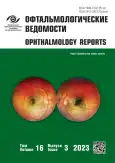The options of ultrasound biomicroscopy in the diagnosis of post-traumatic pathology of the anterior segment of the eyeball
- Authors: Sobolev N.P.1, Uzunyan D.G.1, Shkandina Y.V.1, Teplovodskaya V.V.1, Sudakova E.P.1
-
Affiliations:
- S. Fyodorov Eye Microsurgery Federal State Institution
- Issue: Vol 16, No 3 (2023)
- Pages: 37-44
- Section: Original study articles
- URL: https://journals.rcsi.science/ov/article/view/148218
- DOI: https://doi.org/10.17816/OV492281
- ID: 148218
Cite item
Abstract
BACKGROUND: In the literature, there are scarce publications on the use of ultrasound biomicroscopy in patients with post-traumatic changes in the anterior segment of the eyeball.
AIM: The aim of this study is to study the anatomical and topographic features of post-traumatic conditions of the anterior segment of the eyeball, to determine the criteria for the progression of the disease, to evaluate the possibilities of using the data obtained to determine the tactics of surgical treatment and of individual approach to the choice of implantable optical and diaphragmatic implants.
MATERIALS AND METHODS: The study is based on the analysis of the results of ultrasound biomicroscopy of 360 patients with the sequelae of traumatic injuries of the anterior segment of the eyeball. The patients were divided into groups depending on the nature and degree of damage to the iris. The IA group combined clinical cases where the iris defect was less than 30%; the IB group — more than 30%.
RESULTS: Using ultrasound biomicroscopy, not only the zones of interest were visualized, but the anatomical relationship between the morphological structures of the anterior eye segment and the ciliary body was determined in vivo, their acoustic density was evaluated, and the necessary linear parameters of the eye were measured in the case of ordering and subsequent implantation of intraocular products.
CONCLUSIONS: Ultrasound biomicroscopy should be considered as an integral part of the diagnostic examination of patients at the stage of preparation for opto-reconstructive procedure.
Full Text
##article.viewOnOriginalSite##About the authors
Nikolay P. Sobolev
S. Fyodorov Eye Microsurgery Federal State Institution
Email: viko67@yandex.ru
ORCID iD: 0000-0003-3413-1458
MD, Cand. Sci. (Med.), Ophthalmologist, Chief Physician
Russian Federation, MoscowDzhulietta G. Uzunyan
S. Fyodorov Eye Microsurgery Federal State Institution
Email: u_dzhulietta@mail.ru
MD, Cand. Sci. (Med.), Ophthalmologist
Russian Federation, MoscowYuliana V. Shkandina
S. Fyodorov Eye Microsurgery Federal State Institution
Email: lulyak@mail.ru
ORCID iD: 0000-0003-4447-6599
MD, Cand. Sci. (Med.), Ophthalmologist
Russian Federation, MoscowViktoriia V. Teplovodskaya
S. Fyodorov Eye Microsurgery Federal State Institution
Email: v.teplovodskaya@yandex.ru
ORCID iD: 0000-0002-0546-8433
MD, Cand. Sci. (Med.), Ophthalmologist
Russian Federation, MoscowEkaterina P. Sudakova
S. Fyodorov Eye Microsurgery Federal State Institution
Author for correspondence.
Email: sudakovaekp@gmail.com
ORCID iD: 0000-0001-5654-5411
Resident
Russian Federation, MoscowReferences
- Kanyukov VN, Kazennov AN. Aniridia, aphakia accompanied by retinal detachment: problem and its ways of solution. Ophthalmology in Russia. 2014;11(3):89–93. (In Russ.) doi: 10.18008/1816-5095-2014-3-89-93
- Volkov VV, Troyanovskii RL, Shishkin MM, et al. Sovremennye printsipy pervichnoi oftal’mokhirurgicheskoi pomoshchi pri otkrytoi travme glaznogo yabloka. Coobshchenie 2. Fyodorov Journal of Ophthalmic Surgery. 2003;(S1):10–16. (In Russ.)
- Boiko EhV, Sosnovskii SV, Kulikov AN, et al. Sovremennye vozmozhnosti organosokhrannoi vitreoretinal’noi khirurgii v iskhode tyazheloi travmy glaza. Health. Medical ecology. Science. 2012;(1–2):68. (In Russ.)
- Volkov VV, Boiko EhV, Shishkin MM, et al. Zakrytaya travma glaza (ponyatie, rasprostranennost’, ehpidemiologiya, ehtiopatogenez, gospitalizatsiya, diagnostika, klassifikatsiya). Fyodorov Journal of Ophthalmic Surgery. 2005;(1):13–17. (In Russ.)
- Egorova EhV, Khodzhaev NS, Bessarabov AN, et al. Anatomo-topograficheskie osobennosti irido-tsiliarnoi zony pri khronicheskoi zakrytougol’noi glaukome po rezultatam ultrazvukovoi biomikroskopii. Glaukoma. 2005;(4):24–30. (In Russ.)
- Khamidullaeva MBK, Sidikov ZU, Saidiganieva SKH. Rol ultrazvukovoi biomikroskopii v diagnostike posttravmaticheskikh sostoyanii perednego segmenta glaza. Avitsenna. 2018;(16):39–44. (In Russ.)
- Namazova IK, Jarullazade IC, Jalilova ER, Ibragimkhalilova AB. Ultrasound biomicroscopy in the diagnosis of mechanic injury of the eye in patients of senile age group. Fyodorov Journal of Ophthalmic Surgery. 2012;(4):76–81. (In Russ.)
- Doro D, Deligianni V. Ultrasound biomicroscopy in traumatic aniridia 2 years after phacoemulsification. J Cataract Refract Surg. 2006;32(10):1753–1755. doi: 10.1016/j.jcrs.2006.05.017
- Takhchidi KhP, Egorova EhV, Uzunyan DG. Ultrazvukovaya biomikroskopiya v diagnostike patologii perednego segmenta glaza. Moscow: Izdatelskii tsentr “Mikrokhirurgiya glaza”, 2007. 126 p. (In Russ.)
- Patent RU No. 2704598/ 29.10.2019. Bessarabov AN, Khodzhaev NS, Sobolev NP, Shkandina YuV. Method of determining area of an iris defect. (In Russ.)
- Sobolev NP, Bessarabov AN, Shkandina YuV, Soboleva MA. Reasonable choice of a surgical method for rehabilitation of patients with defects of the iris. Saratov Journal of Medical Scientific Research. 2020;16(2):652–655. (In Russ.)
- Pavlin CJ, Harasiewicz K, Eng P, Foster FS. Ultrasound biomicroscopy of anterior segment structures in normal and glaucomatous eyes. Am J Ophthalmol. 1992;114(4):517. doi: 10.1016/s0002-9394(14)71879-3
Supplementary files










